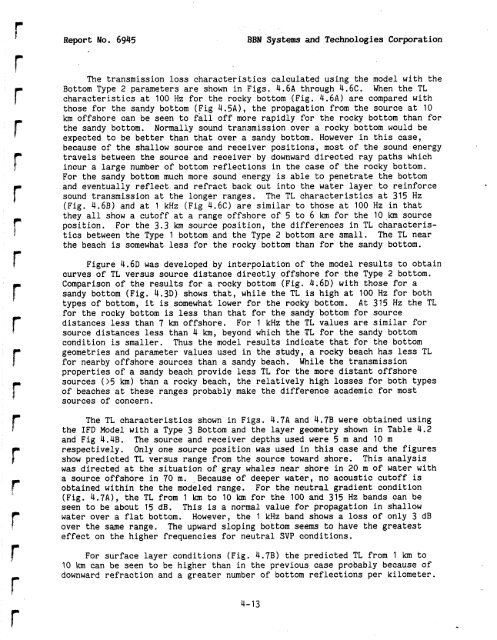Analysis and Ranking of the Acoustic Disturbance Potential of ...
Analysis and Ranking of the Acoustic Disturbance Potential of ...
Analysis and Ranking of the Acoustic Disturbance Potential of ...
You also want an ePaper? Increase the reach of your titles
YUMPU automatically turns print PDFs into web optimized ePapers that Google loves.
Report No. 6945<br />
BBN Systems <strong>and</strong> Technologies Corporation<br />
The transmission loss characteristics calculated using <strong>the</strong> model with <strong>the</strong><br />
Bottom Type 2 parameters are shown in Figs. 4.6A through 4.6C. When <strong>the</strong> TL<br />
characteristics at 100 Hz for <strong>the</strong> rocky bottom (Fig. 4.6A) are compared with<br />
those for <strong>the</strong> s<strong>and</strong>y bottom (Fig 4.5A), <strong>the</strong> propagation from <strong>the</strong> source at 10<br />
km <strong>of</strong>fshore can be seen to fall <strong>of</strong>f more rapidly for <strong>the</strong> rocky bottom than for<br />
<strong>the</strong> s<strong>and</strong>y bottom. Normally sound transmission over a rocky bottom would be<br />
expected to be better than that over a s<strong>and</strong>y bottom. However in this case,<br />
because <strong>of</strong> <strong>the</strong> shallow source <strong>and</strong> receiver positions, most <strong>of</strong> <strong>the</strong> sound energy<br />
travels between <strong>the</strong> source <strong>and</strong> receiver by downward directed ray paths which<br />
incur a large number <strong>of</strong> bottom reflections in <strong>the</strong> case <strong>of</strong> <strong>the</strong> rocky bottom.<br />
For <strong>the</strong> s<strong>and</strong>y bottom much more sound energy is able to penetrate <strong>the</strong> bottom<br />
<strong>and</strong> eventually reflect <strong>and</strong> refract back out into <strong>the</strong> water layer to reinforce<br />
sound transmission at <strong>the</strong> longer ranges. The TL characteristics at 315 Hz<br />
(Fig. 4.6B) <strong>and</strong> at 1 kHz (Fig 4.6C) are similar to those at 100 Hz in that<br />
<strong>the</strong>y all show a cut<strong>of</strong>f at a range <strong>of</strong>fshore <strong>of</strong> 5 to 6 km for <strong>the</strong> 10,km source<br />
position. For <strong>the</strong> 3.3 km source position, <strong>the</strong> differences in TL characteristics<br />
between <strong>the</strong> Type 1 bottom <strong>and</strong> <strong>the</strong> Type 2 bottom are small. The TL near<br />
<strong>the</strong> beach is somewhat less for <strong>the</strong> rocky bottom than for <strong>the</strong> s<strong>and</strong>y bottom.<br />
Figure 4.6D was developed by interpolation <strong>of</strong> <strong>the</strong> model results to obtain<br />
curves <strong>of</strong> TL versus source distance directly <strong>of</strong>fshore for <strong>the</strong> Type 2 bottom.<br />
Comparison <strong>of</strong> <strong>the</strong> results for a rocky bottom (Fig. 4.6D) with those for a<br />
s<strong>and</strong>y bottom (Fig. 4.3D) shows that, while <strong>the</strong> TL is high at 100 Hz for both<br />
types <strong>of</strong> bottom, it is somewhat lower for <strong>the</strong> rocky bottom. At 315 Hz <strong>the</strong> TL<br />
for <strong>the</strong> rocky bottom is less than that for <strong>the</strong> s<strong>and</strong>y bottom for source<br />
distances less than 7 km <strong>of</strong>fshore. For 1 kHz <strong>the</strong> TL values are similar for<br />
source distances less than 4 km, beyond which <strong>the</strong> TL for <strong>the</strong> s<strong>and</strong>y bottom<br />
condition is smaller. Thus <strong>the</strong> model results indicate that for <strong>the</strong> bottom<br />
geometries <strong>and</strong> parameter values used in <strong>the</strong> study, a rocky beach has less TL<br />
for nearby <strong>of</strong>fshore sources than a s<strong>and</strong>y beach. While <strong>the</strong> transmission<br />
properties <strong>of</strong> a s<strong>and</strong>y beach provide less TL for <strong>the</strong> more distant <strong>of</strong>fshore<br />
sources (>5 km) than a rocky beach, <strong>the</strong> relatively high losses for both types<br />
<strong>of</strong> beaches at <strong>the</strong>se ranges probably make <strong>the</strong> difference academic for most<br />
sources <strong>of</strong> concern.<br />
The TL characteristics shown in Figs. 4.7A <strong>and</strong> 4.7B were obtained using<br />
<strong>the</strong> IFD Model with a Type 3 Bottom <strong>and</strong> <strong>the</strong> layer geometry shown in Table 4.2<br />
<strong>and</strong> Fig 4.4B. The source <strong>and</strong> receiver depths used were 5 m <strong>and</strong> 10 m<br />
respectively. Only one source position was used in this case <strong>and</strong> <strong>the</strong> figures<br />
show predicted TL versus range from <strong>the</strong> source toward shore. This analysis<br />
was directeh at <strong>the</strong> situation <strong>of</strong> gray whales near shore in 20 m <strong>of</strong> water with<br />
a source <strong>of</strong>fshore in 70 m. .Because <strong>of</strong> deeper water, no acoustic cut<strong>of</strong>f is<br />
obtained within <strong>the</strong> <strong>the</strong> modeled range. For <strong>the</strong> neutral gradient condition<br />
(Fig. 4.7A), <strong>the</strong> TL from 1 km to 10 km for <strong>the</strong> 100 <strong>and</strong> 315 Hz b<strong>and</strong>s can be<br />
seen to be about 15 dB. This is a normal value for propagation in shallow<br />
water over a flat bottom. However, <strong>the</strong> 1 kHz b<strong>and</strong> shows a loss <strong>of</strong> only 3 dB<br />
over <strong>the</strong> same range. The upward sloping bottom seems to have <strong>the</strong> greatest<br />
effect on <strong>the</strong> higher frequencies for neutral SVP conditions.<br />
For surface layer conditions (Fig. 4.7B) <strong>the</strong> predicted TL from 1 km to<br />
10 km can be seen to be higher than in <strong>the</strong> previous case probably because <strong>of</strong><br />
downward refraction <strong>and</strong> a greater number <strong>of</strong> bottom reflections per kilometer.
















